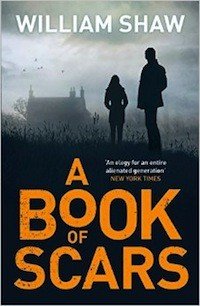You have to feel sorry for Detective Sergeant Cathal Breen, the battered, bruised and emotionally confused cop in William Shaw’s series set in the late 60s. In A Book of Scars, he’s recovering from a bullet wound to the shoulder following the events of the second novel, A House of Knives. He’s also in romantic limbo with Helen Tozer, a former colleague in the Met, though Breen is at least spending time with her while he recuperates on her family’s farm in Devon.
Breen, better known as Paddy because of his Irish roots, soon gets bored of being looked after by Helen’s attentive mother. He starts dwelling on a cold case that has haunted the Tozer family: the murder of Helen’s teenage sister five years earlier. Alexandra was found among a copse on the farm. When Breen is given access to the files by an obliging local cop, he realises the horrific nature of the murder that was never fully explained to the family.
A Book of Scars begins as one of those crime novels in which detective work is undertaken from the sick bed – a literary tradition that includes The Daughter of Time and The Wench is Dead – but it soon picks up pace as Breen returns to the capital. It’s 1969, and he feels that he’s living in London as it ‘woke up from the long dark half of the 20th century’. He meets up with his friend and drugs squad detective, John Carmichael, in a new revolving restaurant at the top of the Post Office Tower (coincidentally, it’s about to re-open to diners for two weeks this summer). He even visits the new Hayward gallery on the South Bank, though he’s not too keen on the modern art.
Shaw’s impeccably researched novels are fascinating in their historical detail, and he also draws attention to injustices that his characters struggle to believe in because of the lack of media attention. Breen makes a connection between Alexandra and a local aristocrat who was her secret lover. Lord Goodstone used to live in Kenya during the Mau Mau Revolt of the 50s, a period of brutality on both sides.
The generation clash in 60s London continues to trouble Breen, though he’s perhaps no longer so certain that the forces of order have the moral high ground over the hippies. Lord Goodstone is a suspicious character, an evening at gentleman’s club Pratt’s reveals the pomposity of the upper classes and there’s an unhealthy rivalry and corruption involving CID and the drugs squad, led by Norman ‘Nobby’ Pilcher.
Drugs are a factor in this case and Breen becomes the subject of much mocking when he transforms himself into a hippy for an undercover job. A drugs squad detective with information on Alexandra’s murder has gone missing. Breen is tasked with dressing up for a late-night evening of psychedelic music at the Roundhouse venue in Camden in search of a dealer with key information. There’s a humorous touch to these uncomfortable situations for the fairly straight-laced cop, which is just as well as the novel heads into darker territory as Shaw confronts the hidden history of empire.
A Song From Dead Lips, the debut in the Breen and Tozer series, impressed me with its portrayal of the swinging 60s and the tensions in a changing society. While that’s a recurring pleasure of these novels, it’s clear that Shaw has developed into an accomplished author over the course of the trilogy (and a fourth book is set up on the final page). The period detail is complemented by a cast of convincing characters and a well-paced plot that fits with the 60s setting. It’s a smart, satisfying read that confidently deals with a convulsive period in British history.
The uncertain relationship between Breen and Trozer could have been tiresome, but in Shaw’s hands their dialogue is as entertaining as an old married couple. When each of them is apparently under threat during this investigation, there’s a palpable sense of peril and the blood-soaked climax is deftly handled. As the title suggests, Breen’s investigation is once again going to leave him nursing a few wounds in the sequel.
Quercus
Print/Kindle/iBook
£6.99
CFL Rating: 4 Stars









